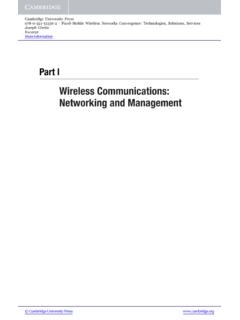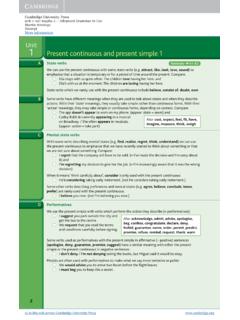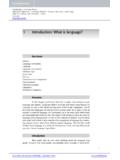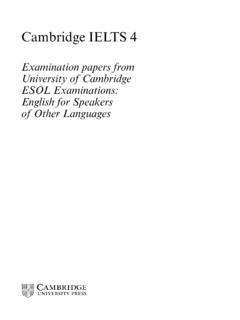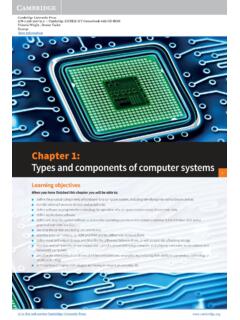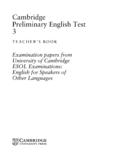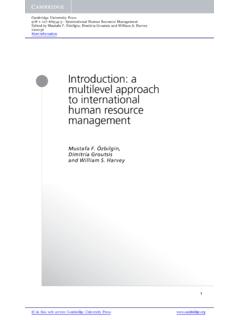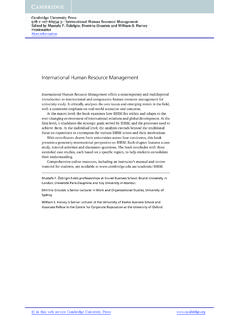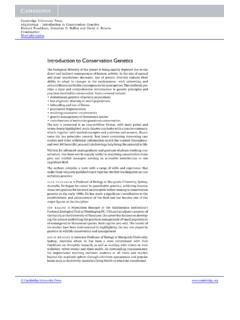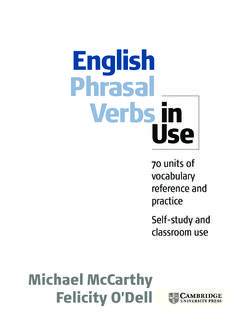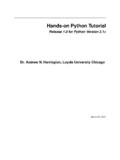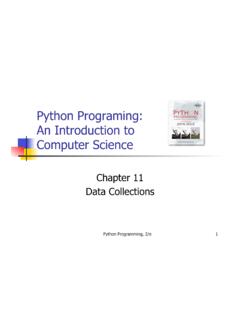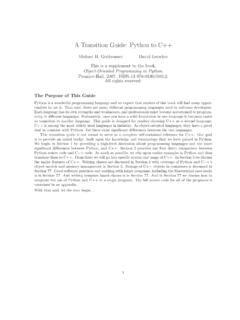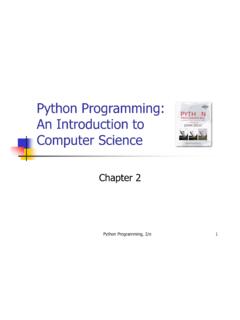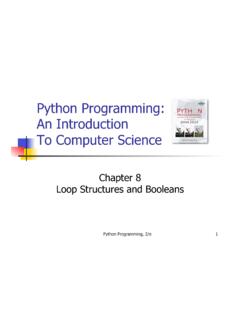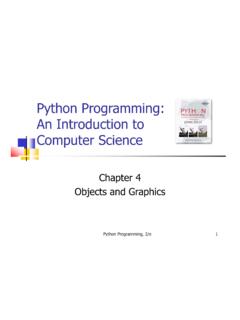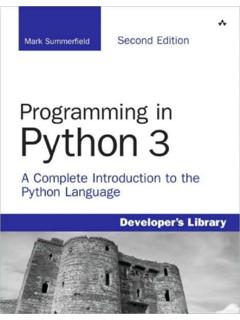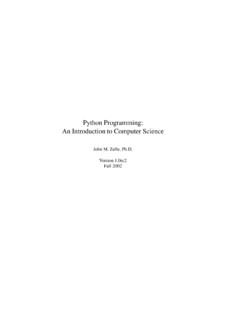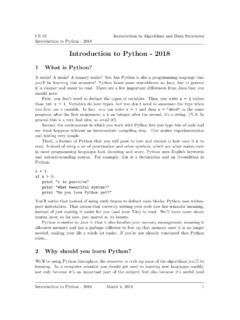Transcription of Python Programming for Biology Bioinformatics and Beyond
1 Python Programming for BiologyBioinformatics and BeyondDo you have a biological question that could be readily answered by computa-tional techniques, but little experience in Programming ? Do you want to learnmore about the core techniques used in computational Biology and bioinfor-matics? Written in an accessible style, this guide provides a foundation for bothnewcomers to computer Programming and those who want to learn more aboutcomputational Biology . The chapters guide the reader through: a complete begin-ners course to Programming in Python , with an introduction to computing jargon;descriptions of core Bioinformatics methods with working Python examples;scientific computing techniques, including image analysis, statistics and machinelearning. This book also functions as a language reference written in straightfor-ward English, covering the most common Python language elements and aglossary of computing and biological terms. This title will teach undergraduates,postgraduates and professionals working in the life sciences how to program withPython, a powerful,flexible and easy-to-use J.
2 Stevens, a biochemist by training, is a Senior Investigator Scientist at theMRC Laboratory of Molecular Biology in Cambridge. He researches three-dimensional genome architecture and provides computational Biology oversight,development and training within the Cell Biology Boucher, a mathematician and theoretical physicist by training, is a SeniorPost-Doctoral Associate and computing technician for the Department of Biochem-istry at the University of Cambridge. He teaches undergraduate mathematics andpostgraduate Programming courses. Wayne is currently developing software for theanalysis of biological molecules by nuclear magnetic resonance in this web service Cambridge University PressCambridge University Press978-0-521-89583-5 - Python Programming for Biology : Bioinformatics and BeyondTim J. Stevens and Wayne BoucherFrontmatterMore in this web service Cambridge University PressCambridge University Press978-0-521-89583-5 - Python Programming for Biology : Bioinformatics and BeyondTim J.
3 Stevens and Wayne BoucherFrontmatterMore informationPython Programmingfor BiologyBioinformatics and BeyondTIM J. STEVENSMRC Laboratory of Molecular BiologyWAYNE BOUCHERU niversity of in this web service Cambridge University PressCambridge University Press978-0-521-89583-5 - Python Programming for Biology : Bioinformatics and BeyondTim J. Stevens and Wayne BoucherFrontmatterMore informationUniversity Printing House, Cambridge CB2 8BS, United KingdomCambridge University Press is part of the University of furthers the University s mission by disseminating knowledge in the pursuit ofeducation, learning and research at the highest international levels of on this title: Tim J. Stevens and Wayne Boucher, 2015 This publication is in copyright. Subject to statutory exceptionand to the provisions of relevant collective licensing agreements,no reproduction of any part may take place without the writtenpermission of Cambridge University published 2015 Printed in the United Kingdom by TJ International Ltd, Padstow CornwallA catalogue record for this publication is available from the British LibraryLibrary of Congress Cataloguing in Publication dataStevens, Tim J.
4 , 1976 Python Programming for Biology , Bioinformatics , and Beyond / Tim J. Stevens, University of Cambridge, WayneBoucher, University of cmIncludes 978-0-521-89583-5 (Hardback) ISBN 978-0-521-72009-0 (Paperback)1. Biology Data processing. 2. Python (Computer program language) I. Boucher, Wayne. II. dc23 2014021017 ISBN 978-0-521-89583-5 HardbackISBN 978-0-521-72009-0 PaperbackAdditional resources for this publication at University Press has no responsibility for the persistence or accuracy ofURLs for external or third-party internet websites referred to in this publication,and does not guarantee that any content on such websites is, or will remain,accurate or in this web service Cambridge University PressCambridge University Press978-0-521-89583-5 - Python Programming for Biology : Bioinformatics and BeyondTim J. Stevens and Wayne BoucherFrontmatterMore informationContentsPrefacepageixAcknowle dgementsx1 Prologue1 Python Programming for biology12A beginners guide5 Programming principles5 Basic data types9 Programflow133 Python basics17 Introducing the fundamentals17 Simple data types24 Collection data types32 Importing modules404 Program control and logic43 Controlling command execution43 Conditional execution46 Loops51 Error exceptions57 Further considerations615 Functions63 Function basics63 Input arguments67 Variable scope72 Further considerations746 Files78 Computerfiles78 Readingfiles81 File reading examples84 Writingfiles92 Further considerations977 Object orientation100 Creating classes100 Further in this web service Cambridge University PressCambridge University Press978-0-521-89583-5 - Python Programming for Biology : Bioinformatics and BeyondTim J.
5 Stevens and Wayne BoucherFrontmatterMore information8 Object data modelling117 Data models117 Implementing a data model119 Refined implementation1329 Mathematics137 Using Python for mathematics137 Linear algebra144 NumPy package150 Linear algebra examples15410 Coding tips160 Improving Python code160A compendium of tips16411 Biological sequences181 Bio-molecules for non-biologists181 Using biological sequences in computing188 Simple sub-sequence properties193 Obtaining sequences with BioPython20512 Pairwise sequence alignments208 Sequence alignment208 Calculating an alignment score214 Optimising pairwise alignment219 Quick database searches22513 Multiple-sequence alignments232 Multiple alignments232 Alignment consensus and profiles233 Generating simple multiple alignments in Python239 Interfacing multiple-alignment programs24114 Sequence variation and evolution244A basic introduction to sequence variation244 Similarity measures253 Phylogenetic trees26215 Macromolecular structures278An introduction to 3D structures of bio-molecules278 Using Python for macromolecular structures286 Coordinate superimposition299 External macromolecular structure modules31216 Array data316 Multiplexed experiments316 Reading array data319viTable of in this web service Cambridge University PressCambridge University Press978-0-521-89583-5 - Python Programming for Biology : Bioinformatics and BeyondTim J.
6 Stevens and Wayne BoucherFrontmatterMore informationThe Microarray class323 Array analysis33617 High-throughput sequence analyses341 High-throughput sequencing341 Mapping sequences to a genome344 Using the HTSeq library35518 Images361 Biological images361 Basic image operations364 Adjustments andfilters369 Feature detection37819 Signal processing382 Signals382 Fast Fourier transform385 Peaks38920 Databases401A brief introduction to relational databases401 Basic SQL402 Designing a molecular structure database40621 Probability421 The basics of probability theory421 Restriction enzyme example425 Random variables431 Markov chains43822 Statistics454 Statistical analyses454 Simple statistical parameters457 Statistical tests462 Correlation and covariance48023 Clustering and discrimination486 Separating and grouping data486 Clustering methods490 Data discrimination50424 Machine learning511A guide to machine learning511k-nearest neighbours515 Self-organising maps518 Feed-forward artificial neural networks523 Support vector machines534viiTable of in this web service Cambridge University PressCambridge University Press978-0-521-89583-5 - Python Programming for Biology : Bioinformatics and BeyondTim J.
7 Stevens and Wayne BoucherFrontmatterMore information25 Hard problems545 Solving hard problems545 The Monte Carlo method547 Simulated annealing55726 Graphical interfaces566An introduction to graphical user interfaces566 Python GUI examples56827 Improving speed582 Running things faster582 Parallelisation583 Writing faster modules587 Appendices606 Appendix 1 Simplified language reference607 Appendix 2 Selected standard type methods and operations621 Appendix 3 Standard module highlights634 Appendix 4 String formatting653 Appendix 5 Regular expressions658 Appendix 6 Further statistics668 Glossary671 Index696 The colour plates are to be found between pages 342 and 343viiiTable of in this web service Cambridge University PressCambridge University Press978-0-521-89583-5 - Python Programming for Biology : Bioinformatics and BeyondTim J. Stevens and Wayne BoucherFrontmatterMore informationPrefaceMany years ago we started Programming in Python because we were working ona large computational Biology project.
8 In those days choosing Python was notnearly as common as it is today. Nonetheless things worked out well, and as ourexpertise grew it seemed only natural that we should run some elementary Pythoncourses for the School of Biology at the University of Cambridge, where we wereemployed. The basis for those courses is what turned into the initial idea for thisbook. While there were many books about getting started with Python and somethat were tailored to Bioinformatics , we felt that there was still some room forwhat we wanted to put across. We began with the idea that we could write somechapters in relatively straightforward English that were aimed at biologists, whomight be complete novices at Programming , and have other sections that areuseful to a more experienced programmer. Also, given that we didn t considerourselves to be typical bioinformaticians, we were thinking more broadly thanjust sequence-based informatics, though naturally such things would be felt that although we couldn t anticipate all the requirements of a biologicalprogrammer there were nonetheless a number of key concepts and techniqueswhich we could try to explain.
9 The end result is hopefully a toolkit of ideas andexamples which can be applied by biologists in a variety of J. Stevens andWayne Boucher,Cambridge, January in this web service Cambridge University PressCambridge University Press978-0-521-89583-5 - Python Programming for Biology : Bioinformatics and BeyondTim J. Stevens and Wayne BoucherFrontmatterMore informationAcknowledgementsWe extend our sincere thanks to a group of intrepid volunteers who have beeninvaluable in the proof-reading and testing of this book: Olga Tkachenko, MagnusLundborg, Neil Rzechorzek, Rasmus Fogh, Simon Fraser and Tom thanks also go to David Judge, who has run the bioinformaticsteaching facility at Cambridge for many years and who made it very easy to givethe Python courses that eventually led to this acknowledge the support of the Medical Research Council and theBiotechnology and Biological Sciences Research Council, the UK funding bodieswho have funded the scientific projects that we have been involved with over theyears.
10 This has allowed us to use and develop our Python Programming skillswhile remaining gainfully in this web service Cambridge University PressCambridge University Press978-0-521-89583-5 - Python Programming for Biology : Bioinformatics and BeyondTim J. Stevens and Wayne BoucherFrontmatterMore informatio
